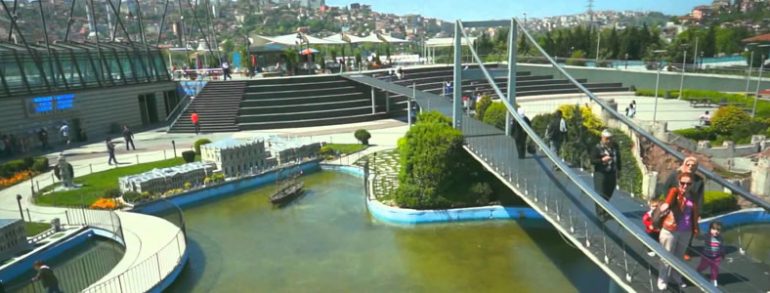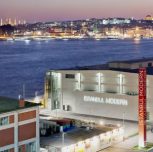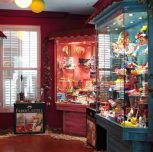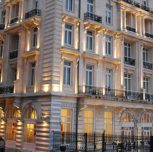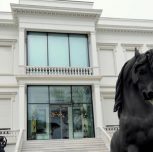On the 30th of June 2001, Miniaturk, which is the first miniature park of Turkey, had its foundations laid down and it was on the 2nd of May 2003 that it opened to the public. The museum, which also offers audio guidance services, is open every day of the week.
Miniaturk, which is located in Sutluce Istanbul, is the largest miniature city in the World, covering an area of 60,000 squaremetres, which consists of 15,000 squaremetres for a model area, 40,000 squaremetres of open space, 3500 squaremetres of indoors, 2000 squaremetres of pools and waterlines and 500 squaremetres of parking space.
Miniaturk, which consists of works from both Turkey and the Ottoman geographies, presents these works with a 1/25 scale. 59 of these models are from Istanbul, 51 from Anatolia, 12 from locations, which were from the Ottoman lands but currently are not within the borders of Turkey, and overall have 122 models on display. However, possible additions in the future have been taken into consideration and thus, reserved areas have been formed for possible extensions.
Polyurethane elements have been used in the production of the models.
The park, which has brought together the marks of many cultures and civilisations including Aya Sophia to Selimiye, from Rumeli Hisari to Galata Tower, from the Safranbolu Houses to the Sumela Monastery, from Qubbetus-Sahra to the remains of Mt Nemrut, from the Mostar Bridge to the Mevlana Mausoleum, from Bursa Ulu Mosque to the Basilica Cistern, has also reanimated works like the Artemis Temple, the Mausoleum at Halicarnassus and the Ajyadd Fortress, which have not survived.
There has been great effort in including every civilisation that has ruled Anatolia or its surrounding areas at Miniaturk. The shadows of the Ancient Times to the Byzantines, from the Seljuks to the Ottomans, a history of 3000 years, has been moved to the Golden Horn at Miniaturk.
The Miniaturk Project, which has aimed to create an ‘epic’ environment within itself, consists of all the art and models from Anatolia, Istanbul and the early Ottomans. While these sections have been allocated with minor landscaping, a tour route that orientates its visitors has been implemented.
The audio guidance service located next to every model is a system implemented for the first time at Miniaturk. This service provides 9 languages including Turkish, English, French, German, Russian, Arabic, Persian, Japanese and Spanish.
Along with the models displayed like in an open air museum, there have also been spaces designed for the purposes of providing its visitors an enjoyable time. These include an ampitheater accommodating 400 people, a store selling Miniaturk souveniers, a Miniland play area for children, a helicopter simulation that takes the visitors on a ride of Istanbul and Turkey, the Trojan horse, a castle, the Miniaturk express train touring around the museum, chess, a labyrinth, go carts and operated boat games.
Furthermore, two other museums called the Panorama Victory Museum and the Crystal Istanbul Museum are also located within the park.
THE PANORAMA VICTORY MUSEUM
This museum was established as a gift celebrating the 80th anniversary of the Republic of Turkey, and together with the special sounds and light effects of the Independence War, the exhibition of Ataturk’s Photographs can be visited within this Panorama Victory Museum.
THE CRYSTAL ISTANBUL MUSEUM
“Crystal Istanbul” located in Miniaturk, which is the one and only crystal museum in the World, is unique in that it integrates crystal glass, light and high laser technology with history and presents it as a three dimensional museum.
The sixteen most valuable historical artifacts of Istanbul, and the greatest figures that have been formed by the use of laser-beaming crystal are all presented here at “Crystal Istanbul”.
These are the works that are exhibited today at “Crystal Istanbul”; the Galata Tower, Aya Sophia, Sultanahmet Mosque, Ciragan Palace, Fatih Mosque, Haydarpasha Terminal, the Istanbul Metropolitan Municipality Building, Istanbul University, the Maiden’s Tower, the Church of St Anthony, Topkapi Palace, Eyup Sultan Mosque, Rumelian Castle, Dolmabahce Clock Tower, Suleymaniye Mosque and the Bosphorus Bridge…
THE MODELS ON EXHIBITION AT MINIATURK:
1. Group: The models on exhibition belonging to Anatolia
-The Konya Mevlana Mausoleum, which was built in 1274, and is one of the most beautiful works belonging to the Seljuk Era, with its turqiose tiled dome
– Architect Sinan’s work of Mastery, the Edirne Selimiye Mosque, which is the most glorious example of Ottoman architecture
– Anitkabir, which is where Ataturk is buried in Ankara
– The Izmit Clock Tower, which was built to celebrate the 25th year of enthronment of Sultan Abdulhamit
– The building of the Grand National Assembly of Turkey
– The Ishak Pasha Palace located in Dogubayezit in the city of Agri which was built in the year 1785
– The Ankara Ziraat Bank, which is one of the products of the First National Architectural Era.
- Haci Bayram Mosque, which is one of the most important spiritual centres of Ankara
- The Temple of Augustus, belonging to the 10th century, which is also located right next to the Haci Bayram Mosque in Ankara
- The Yivli Minara Mosque, built by Alaaddin Keykubat, at Antalya Kaleici.
- The Canakkale Martyrs Monument, which was built in memory of the 250 thousand martyrs
- The Safranbolu Houses, which are the rare samples of the Traditional Turkish Houses that have survived up until today
- The Malabadi Bridge, which is the world’s widest stone building, built over the Batman Creek in Diyarbakir, Silvan
- The Stone Bridge, Seyhan Bridge built over Seyhan River in Adana belonging to the 2nd century
- The Kirsehir Asik Pasha Tomb belonging to the Eretna Seigniory
- The Halil Rahman Mosque and the Balikli Lake in Sanliurfa, which is one of the most important places in Turkey
- The Diyarbakir Ulu Mosque in Anatolia, which is one of the oldest mosques in Anatolia,
- Bursa’s symbol, The Green Tomb, which was built in 1421 and belonged to Celebi Mehmed
- The Ertugrul Gazi Tomb located in Bilecik Sogut, which belonged to Osman Gazi’s father
- The Bursa Ulu Mosque, built in the year 1400, by Yildirim Bayezid
- The Erzurum Double Minara Madrasah from the Seljuk Era
- The Somuncu Baba Complex located in Malatya Darende
- The Seljuk Isa Bey Mosque, which belonged to the Anatolian Seigniory and is the oldest and most spectacular of its kind
- The Konya Alaaddin Mosque, which was built in 1200, by the Seljuk Sultan Alaaddin Keykubat
- The Manisa Muradiye Mosque, which was built by Sultan Murad III, in the year 1586
- The Amasya Yaliboyu Houses, belonging to the 19th century, located on the shores of Yesilirmak River in Amasya
- The Izmir Clock Tower, which has become the symbol of the city, located in the Konak Square
- The remains of Mt Nemrud belonging to the Commagene Kingdom, located at an altitude of 2206 metres in Adiyaman Kahta
- The Trabzon Sumela Monastery, in the form of a castle, which has been built inside of a mountain at an altitude of 1300 metres
- The traditional Mardin Stone Houses which have been built by yellow limestones and face stones
- The House of the Virgin Mary in Izmir belonging to the Roman era
- The Konya Karatay Madrasah which is one of the masterpieces of Seljuk stonemasonry
- The Karaman Hatuniye Madrasah, which was built in 1382 by the Karamanid Dynasty
- The Hittite Civilisation’s Sphinx Door, the Yazilikaya Rock Sanctuary and City Walls
- The Ephesus Celsus Library belonging to the Roman era located in Izmir, Selcuk
- The Gok Madrassah, which is a Seljuk monument and which has become the symbol of Sivas
- The Temple of Artemis located in the Ephesus ancient city from the 3rd and 4th centuries B.C. located in Izmir Selcuk
- The Mausoleum of Halicarnassus, belonging to the 4th century BC, which was built in Bodrum with the intention to compete with the Egyptian Pyramids
- The Pergamon Altar, built in the antique city of Pergamon in Izmir Bergama, which was taken to Berlin by the Germans in 1878
- The Aspendos Theatre, built in the Aspendos antique city in Antalya, during the 2nd century
- The Sivas Divrigi Ulu Mosque, built by Mengucoglu Sultan Ahmed Shah in the year 1229 and which has also been included in the UNESCO World Heritage List
- The famous Konya Ince Minarah Madrassah with its minarah adorned with tiles and its door adorned with stones
- The biggest caravansaries of the Seljuks in Aksaray called Sultan Han
- The Nigde Alaadin Mosque built by Alaaddin Keykubat
- The Hoodoos located in Nevsehir, which are one of its kind and all naturally formed
- The Doner Kumbet, built in Kayseri in the year 1276, with its yellow face stones
Pamukkale located in Denizli, which is the only natural formation of its kind in the World - The Haci Bektash Veli Complex in Nevsehir made in the name of the great Turkish Sufi
- The aerial ropeways, which is one of the symbols of Bursa
- The Ataturk Dam, which is one of the most important architectural structures of the World and constitutes the most crucial part of the GAP project
- The Zeynel Bey Tomb, Zeynep Bey Complex and Zeynel Bey Hamam models, which are the symbol of Batman Hasankeyf, were the final works added to Miniaturk in the year 2013
2. Group : The models on exhibition belonging to Istanbul
- The Istanbul Ataturk Olympics Stadium, which is a new and modern structure
- The Istanbul Municipality Building, which was built by architect Nevzat Erol who had completed a national competition with a first rank, during the year 1953
- Mimar Sinan’s mausoleum in Suleymaniye
- The oldest Turkish monument in Istanbul, the Anatolian Castle, which was built by Yildirim Bayezit in the year 1394
- The pearl of the Bosphorus, the Maiden Tower, which is one of the symbols of Istanbul
- The Kuleli Military College located in Cengelkoy, which was built by Sultan Abdulaziz in the year 1863
- The Kaymak Mustafa Pasha Mosque located in Cengelkoy, which is one of the most beautiful mosques of the Bosphorus
- The Eyup Sultan Mosque, which was built by Sultan Mehmed II, the conqueror of Istanbul, where the flagbearer of the Prophet Mohammad Abu Ayub Al-Ansari had become a martyr during the seige of Istanbul
- The Valide Sultan Mosque, which was built on the order of Pertevniyal Valide Sultan in 1871, and which exhibits a different image from the other mosques with its neogothic design
- The Pertevniyal College built on the order of Pertevniyal Valide Sultan in 1872 as the Mahmudiye Ottoman Junior High School
- The Beylerbeyi Palace, built on the order of Sultan Abdulaziz in 1865, by Architect Sarkis Balyan with a neoclassical design
- The Khedive Palace, which is located in a coppice forest in Cubuklu, and which was built by the Italian architect Delfo Seminati on the order of the Egyptian Khedive Abbas Hilmi Pasha in the year 1907
- The Ciragan Palace, which is the most elegant structures built on the order of Sultan Abdulaziz,
- The Dolmabahce Palace, which is the most famous and grand palace of the Bosphorus, built in the year 1856 on the order of Sultan Abdulmecid
- The Dolmabahce Clock Tower located next to the Dolmabahce Palace
- The Kabatas Boys’ High School on the Bosphorus in Kabatas
- The Bosphorus Bridge, which was opened in the year 1973, connecting the Asian and European continents
- Ataturk Airport, which was opened in the year 1938 with the name Yesilkoy, and which was the first airport in Turkey
- Aya Sophia, which was built during the East Roman Empire and is accepted to be the symbol of the conquest of Istanbul and is one of the most important monuments of World heritage
- The Haseki Hurrem Bathhouse, which is located between Sultanahmet and Aya Sophia, and built for Hurrem Sultan in 1556
- Turkey’s only mosque with six minarets, the Sultanahmet Mosque, which is also called the Blue Mosque, was built by Sedefkar Mehmet Agha on the order of Sultan Ahmed I in 1609
- The Sadullah Pasha Waterside Mansion located in Cengelkoy, which is one of the most beautiful mansions on the Bosphorus
- The Northern Marine Shelf Command Post located on the shore of Halic in Kasimpasha, and which was built as a Chamber during the era of Sultan Abdulaziz
- The Topkapi Palace, which was built on the order of Mehmed II, the conqueror of Istanbul, between the years 1460-1478, and which was the centre of administration of the Ottoman Empire for a period of 400 hundred years as well as the official residence of the Ottoman Sultans
- The Walled Obelisk, with a height of 32 metres, which was made with roughly cut stones during the 4th century
- The Serpent Column, which belongs to the 5th century BC, and was made in memory of the victory against the Persians by the unity of 31 Greek counties, was built by melting all of the weapons of the Persians
- The Obelisk of Theodosius, which was erected at the Karnak Temple located in Egypt in 1547 BC, was brought to Istanbul in the year 390
- The German Fountain, which was built in Germany on the order of the German Emperor Wilhelm II in the year 1901 as a gift for Abdulhamid II and assembled in the Sultanahmed Sqaure
- The Aya Irene Church, which is located within the walls of the Topkapi Palace, and which was built in the year 537 on the order of the Byzantine Emperor Justinian I together with Aya Sophia
- The Basilica Cistern which was built on the order of Justinian during the 6th century for the purposes of delivering water to the city
- The Sogukcesme Street which is located at the end of the Imperial Gate accommodates the historical Istanbul houses which lean on the walls of the Topkapi Palace
- The Fountain of Sultan Ahmed III, which is the most beautiful and famous fountain in Istanbul, is located in Sultanahmet Square and was made for Sultan Ahmed III on the order of the Grand Vizier Damat Ibrahim Pasha
- The Grand Post Office which was opened in the year 1909 and is considered to be the pioneer of the First National Architecture Movement
- The Haydarpasha Train Station which is considered to be one of the symbols of Istanbul
- The Istanbul Boys’ College, which was built as the Ottoman Public Debt Administration Building in the year 1897
- The Kucuksu Pavilion, also known as the Goksu Pavilion, built on the order of Sultan Abdulmecid by the Architect Nikogos Balyan in the year 1856
- The Rumelian Castle built on the Bosphorus on the order of Mehmed II in the year 1452
- The Taksim Republic Monument built in Italy by an Italian sculptor Pietro Canonica, in the year 1928
- The Ahrida Synagogue built on the Balat Kurkcu Cesme Road, for the Jews who were migrating from Ohri Macedonia during the 1400s
- The Galata Tower, which is also one of the most important symbols of Istanbul, which was built in the year 1348
- The Kariye (Chora) Museum built on the order of Emperor Justinian during the 6th century
- The Darussafaka College built in Fatih-Carsamba in 1873, for the education of gifted and poor children is the first private college which was for free
- The Church of St Anthony, which is the biggest Catholic Italian church in Istanbul
- Galatasaray High School built in 1868 as the Galatasaray Sultan’s University
- The Molla Gurani Mosque, which is located on Molla Semseddin Mosque Street in Vefa, and was converted from a church into a mosque by Sheikul Islam Molla Gurani
- The historical Istanbul Rampart and Yedikule Dungeons, which is 21 kilometres long, has more than 50 doors and more than 300 towers
- The Kirk Fountain Water System, built by Mimar Sinan between 1554-1563 by the order of Kanuni Sultan Suleyman, is the biggest historical water system in Turkey, including the following: the Kirazli Reservoir, the Crown Pool, Maghlova Aqueduct, Guzelce Aqueduct, the Pasha Aqueduct Cove, Shahzade Water Gauge, the Saliha Sultan Fountain.
2 Group : The models on exhibition belonging to other countries:
- The Ajyad Castle built in Mecca during the 16th century for the purposes of protecting the Kabaah and demolished in the year 2002 to build a hotel in its place
- The Mehmed Ali Pasha Mosque, which is an Ottoman monument, located on the most beautiful hills of the Cairo Castle
- The Damascus Station, which was a stop in Damascus of the historical Hijaz Railways, built in the year 1911
- The Damascus Gate, which was one of the seven Gates of the 4 kilometres long Sultan Suleyman Ramparts surrounding Jerusalem
- Qubbetus Sahra in Jerusalem, which was built on the order of Caliph Abdulmelik bin Marwan in the year 691 and is one part of the Al-Aqsa complex
- The Al-Aqsa Mosque in Jerusalem, which was the first Qiblah of Islam and one of the most important three mosques
- The Gul Baba Mausoleum, which was built in Budapest during the 16th century and is considered to be one of the most important Turkish works in the Balkans
- The Sultan Murat Tomb which was built in the name of Sultan Murat Hudavendigar, who became a martyr during the Kosovo War and is the oldest Ottoman architectural work in Kosovo
- The Romania Gazi Ali Pasha Mausoleum built during the 17th century is one of the most important Ottoman relics in the Balkans
- The house in Thessalonica where Mustafa Kemal Ataturk was born and where his family lived in for many years
- The Mostar Bridge, which is one of the biggest single-arch stone bridges was reconstructed in the year 2003 by Architect Hayrettin after it was destroyed during a bombing in the year 1993
- The Ertugrul Frigate, which was launched into the sea during the era of Sultan Abdulaziz, and which was also sent to Japan during a friendly visit. After it sunk on its return from Japan, 533 of our marines had passed away.
CONTACT DETAILS
Address: Sütlüce Mahallesi, İmrahor Caddesi 34445 Sütlüce - Beyoğlu / İstanbul Tel: 0 212 222 28 82 Fax:0 212 222 21 06 E-Mail:info@miniaturk.com.tr
VISITING HOURS
The museum, in the summer season of daily 09.00-19: 00 is open to visitors.


